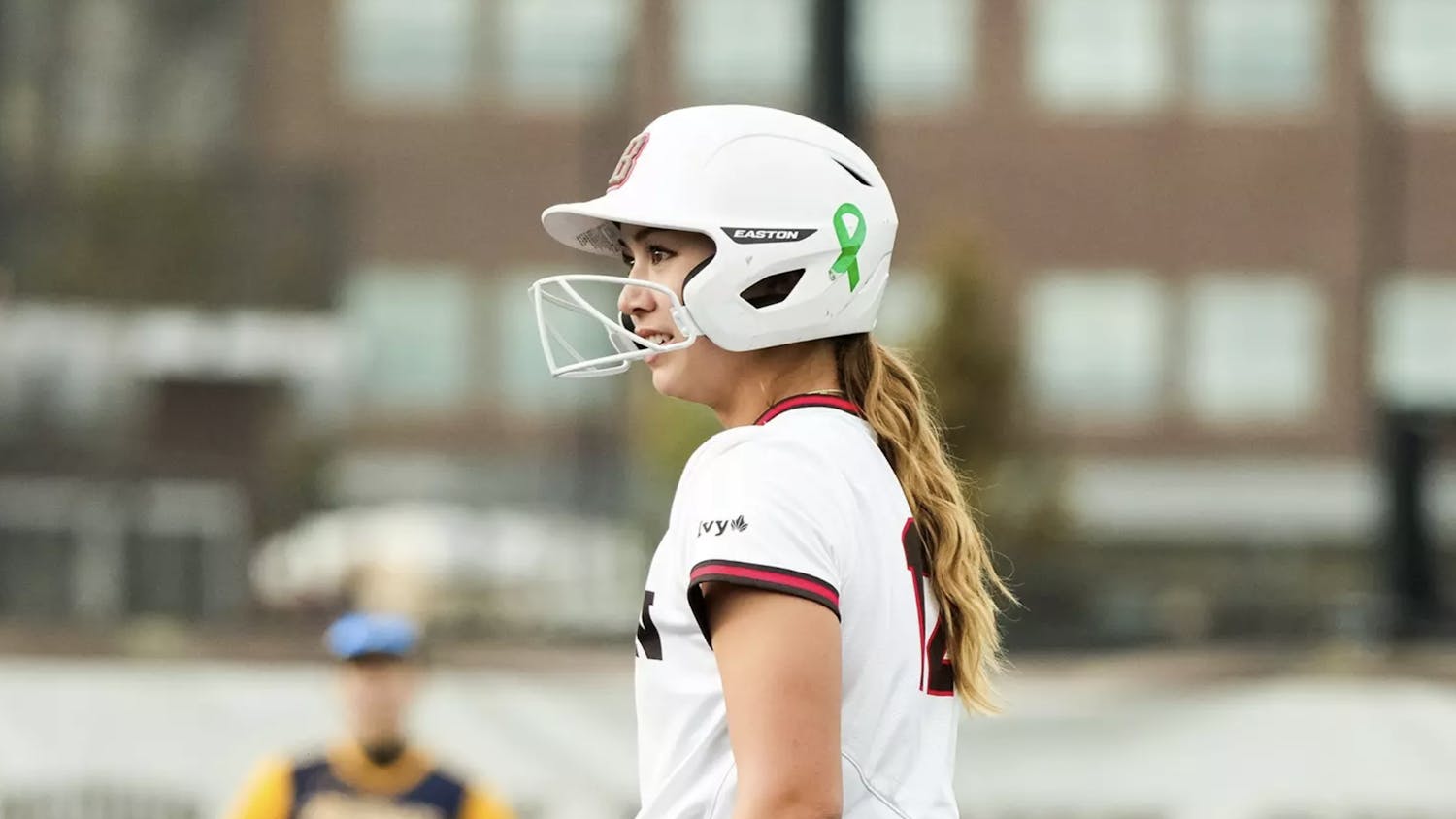By Alex Mittman Contributing Writer
The fencing team had a rough weekend, besting only Yeshiva University and Hunter College in the overall standings of a seven-team event. The men's squad notched another victory over NYU by 5 bouts, 16-11.
Men's sabre had by far the best group performance of the day, with all of the fencers winning at least as many bouts as they lost. Peter Tyson '12 went 12-6, Teddy Weller '13 11-6, Nick Deak '14 12-5, and Brandon Tomasso '13 had an even score of 1-1. Weller said that the team is "on a good run right now," and the players are hopeful for a good performance through the remainder of the season.
Both the women's and men's teams defeated Yeshiva, 23-4.
"It was a good round to start with and get us in the mood for the rest of the day," said co-captain Alexander DePaoli '11.
But the team struggled overall.
"This was our hardest yet," said Katherine Hawrot '14.
Women's foil posted positive scores, with Avery Nackman '13 going 11-4, captain Yukiko Kunitomo '12 9-5, Vivian Truong '12 6-4 and Hawrot 9-6. Cory Abbe '13 once again led the Bruno epeeists with a 13-5 record.
Men's epee posted some impressive scores on the day, as Kelly McGuire '13 went 11-7 and Ben McDonald '14 posted a 10-7 record. The epee squad defeated Duke, 5-4, in a close battle. The team will be back in action this weekend, when it will compete in its biggest event of the year, the Ivy League Championship.
To the Editor: Sworn in in July of 2001, Ms. Simmons has reached or exceeded the customary term of a college President, and a case could be made for beginning a search for a new president to take Brown into the next decade of growth and beyond. Our president has done an exemplary job during her tenure, but the time has come to make way for new blood and new directions for Brown. Olafur Gislason '74 P'06
Coal to the Swearer Center for Public Service, which is just now changing its compensation polices to comply with the Fair Labor Standards Act of 1950. If the entire University was as behind the times as Swearer, the faculty would still be full of white males. Oh, wait.
A diamond to the professor at Northwestern University's Kellogg School of Management whose forthcoming study of elite consulting, finance and law firms found that, compared to their counterparts at Harvard, Princeton and Yale, Brown graduates have little chance of landing jobs at those firms. On second thought, sounds like we're going to need that diamond a lot more than you.
Coal to the irresponsible parents of Noah Bareto, the eighth-grader who testified in favor a marriage equality bill and dismissed religious arguments against gay marriage by saying, "In the Bible they ate children. We don't eat children." He is way too young to be reading a book like that.
A diamond to President Ruth Simmons who attended the dedication of the brand new Perry and Marty Granoff Center for the Creative Arts last night. "Tonight, to me, is about love," Simmons said, meaning "money."
Cubic zirconium to Computing and Information Services for deciding not to renew a contract with Adobe that allows students to download programs such as Photoshop for free. Now that the only things we can get online for free are Wikipedia and pornography, we feel a lot less guilty for using them.
A diamond to Irish novelist John Banville, for reading a "bleeding chunk" of his latest work in Solomon 001 Tuesday. With the Fish Company closed, its good to know students still have a place to go to get their share of bleeding chunks.
A cubic zirconium to Chaplain Janet Cooper Nelson, who said she chose Harvard Divinity School over Harvard Law School because she did not like the law school's "sort of hazing process." Now we know why, after 21 years on campus, Cooper Nelson has not once rushed D Phi.
A diamond to malaria researcher and Professor of Applied Mathematics George Kianadakis, who said of red blood cells, "They cannot travel through the capillaries if they are stiff." That's what he said.
A diamond to the Brown Cubing Club, which held its second annual Rubik's Cube competition Saturday. Mom and Dad, if you hear a bunch of Brown students are going to twist one up, this is what they're talking about.
A diamond to the Corporation, the majority of whose members hail from the financial sector. Now let's loan out that diamond, securitize and collateralize the debt, dump it off on a retirement fund in Germany and get The Herald's endowment moving again.
SHARPE REFECTORY
VERNEy-WOOLLEY DINING HALL
LUNCH
DINNER
Today
february 11
ToMORROW
february 12
Beginning today, students will be able to declare their concentrations electronically using a new feature on Advising Sidekick, the web-based tool run by the Office of the Dean of the College. The process to submit concentration forms will remain largely the same, as will the forms themselves, said Katherine Bergeron, dean of the College. The main benefit to this new online feature is that it creates a paperless system, Bergeron wrote in an e-mail to The Herald. The "green system" will eliminate the need to download PDFs, print them, fill them out and make multiple copies for a concentration adviser. Students will still have to complete a personal statement and course plan in addition to their degree, concentration and track declarations, but they will be able to complete the forms electronically through the Advising Sidekick program. Advising Sidekick was developed by Computing and Information Services and the University Library and launched in the summer of 2009 for the class of 2013, according to Christopher Keith, director of information technology. After making their declarations, students will be assigned advisers via e-mail, whom they will then have to meet with in person. The advisers will be able to comment on the declaration, and the students will be informed again via e-mail to make any necessary changes online before meeting with their advisers a final time to receive an electronic signature on their forms, Bergeron wrote. The program was designed to provide "an enhanced advising continuum for undergraduate students," Keith wrote in an e-mail to The Herald. "We hope the system will facilitate communications and exchange of data between students and their advisers." Spencer Lawrence '11 called it a "great idea" that supports the University's "Brown is Green" pledge to increase environmental sustainability. - Leigh Carroll
By Greg Jordan-Detamore Senior Staff Writer About 350 attendees explored the Perry and Marty Granoff Center for the Creative Arts at its dedication ceremony last night, taking in the wide variety of student artwork - incorporating visual art, sound, video, dance and sculpture - that adorns the latest addition to the campus.
The building - which has been open for classes since Jan. 26 - will not be host to any one department, but will "manifest new modes of dialogue between different disciplines," said Richard Fishman P'89, director of the Creative Arts Council and a professor of visual art, who has championed the building since long before it existed.
The building was entirely donor-funded, Ronald Margolin, vice president for international advancement, told The Herald. The fundraising goal was $52 million - $38 million for construction, $2 million for program development, and $12 million for an operating endowment - and a total of $60 million was raised.
"Creativity and innovation are inextricable," Rocco Landesman, chair of the National Endowment for the Arts, told the audience during his keynote address. "What I love about the building are the unexpected adjacencies."
"This place makes me want to sing," Fishman said."The development of the Granoff Center has been brought about by a powerful yet simple principle - that when we share our intellectual capital and our resources, we can achieve something quite different than that which we can do alone."
"It's a gift that w
ill nurture the creative minds of students for years to come," Fishman said.
"Tonight, to me, is about love," President Ruth Simmons said. "Richard Fishman had an idea and couldn't let go of it."
As a new experimental space, the Granoff Center will be an invitation for both success and failure, Landesman said. But "failure is the key to innovation," he said. "When failing is fun, its okay to try again."
Interdisciplinary pursuits are often given leftover spaces - "hand-me-downs," said Elizabeth Diller, a principal from the architecture firm behind the building, Diller, Scofidio & Renfro. Like others, she celebrated the creation of a space dedicated to interdisciplinary collaboration. "Everything here is about in-betweenness," she said. "It's yours, and we can't wait to see what comes out."
Several of the speakers made reference to the relationship between the experimental nature of the New Curriculum and the experimental nature of the Granoff Center. "We have created something together that could only take place at Brown," Fishman said.
Several scenes from Sock & Buskin's fall 2010 production of "Pippin" were performed, as well as two classical music pieces. "It's a lovely new space," Meredith Mosbacher '11.5, one of the actors, told The Herald. "There are so many possibilities for it."
"It was very emotional for me," Fishman's son, Harris Fishman '89, told The Herald after the ceremony. "For (Richard) to be here this day with this building, it was very powerful."
"I feel really thrilled," Perry Granoff P'93 told The Herald. "I thought this was an amazing ceremony."
"The laboratory has been created, and now the fun part begins," said Martin Granoff P'93.
"Seeing all that creativity made you think differently," Simmons told The Herald after the event. "If a building can have energy, this one certainly has it."
Corporate profiteers run our university. Most administrators will never admit this because their economic and social status is rooted in Brown's increasingly corporate path. Many students don't see it or don't care, blissfully happy with our privileged lives here and the lives we are promised after - blissful customers ready to become blissful corporate workers. But if you ask almost anyone who has worked here for more than a decade - facilities or dining or library workers, tenured professors and even certain administrators - they'll tell you things are changing at Brown, and not for the better. There's been much talk about the fabled "Brown, Inc." It seems to me that before we get ahead of ourselves, we need to establish the conversation. Corporatization must be thought of as the increasing evacuation of Brown's public service mission - written into our charter - in favor of profit interests. In a global context, this has been called "neoliberalism" or "Empire." I would ask that we remember this public service mission relates just as much to students as it does to every community Brown affects. These communities, whether consisting of our workers or the businesses in which we invest, are increasingly graded like bottom-line profits and less and less like people. Even some students are happy to think of Brown as a business and to compare its students to consumers, as if education was a product, not a process. Are elementary and secondary schools - public or private - merely businesses, too? Just as health care in our country is a privilege and not a right, so too is higher education becoming an increasingly costly privilege. When administrators, Corporation members and students talk about endowment losses, tuition or financial aid increases, or how we compare to our "peer schools"; when they use words or phrases like "efficiency," "centralization" and "budget cuts"; when the e-mails from the Career Development Center are most frequently about investment banks - what we are dealing with is the corporatization of Brown. And if anybody can justify the existence of the new Perry and Marty Granoff Center for the Creative Arts, or why it was worth $40 million - nearly half of last year's budget shortfall of $95 million that led to 66 people losing their jobs (not to mention the 139 "voluntary" retirements), or the 31 more that lost their jobs the year before - I would be amazed. Forty million dollars would've helped the $81.5 million going this year towards financial aid - a program that Provost David Kertzer '69 P'95 P'98 described as "increasingly expensive to sustain" at a once a year public forum of Brown's budgetary committee, the University Resource Committee, this past fall. Everyone jumps to point out that money set aside for construction comes from targeted gifts - failing to recognize the role that targeted fundraising like the Campaign for Academic Enrichment plays in the targets funded. It's worth noting that of the Campaign's $1.61 billion raised only $6.2 million were set aside for "the Alumni of Color Initiative," a special initiative split between raising money for endowed scholarships, the annual fund, "Third World Transition Programs" and academic programs. It would be reductionist to claim that responsibility is not a complex question. For the moment, let's keep it simple. I am not Marxist-Leninist, I'm not even a socialist - but I'm going to quote Lenin on this one - "Who stands to gain?" Who benefits from the opacity and unaccountability with which this University operates? The same people who operate veiled - the president who rarely meets with her students, the investment office whose location is kept off its website and won't permit students to visit - I know from experience - and the Corporation which seals its minutes for 25 years. Is it any surprise that our highest governing body includes people like Steven Rattner '74 P'10 P13, who recently settled $6.2 million dollars for "peddling influence" in the securities industry and is being sued by the State of New York for $26 million more? Or Steven Cohen P'08, whose hedge fund SAC capital is at the center of a major insider trading investigation? Forgive me if I'm not thrilled that last year they welcomed to their ranks Brian Moynihan '81, CEO of Bank of America - a company of whose role in the current financial crisis one would need to be an ostrich to be unaware of. I'm sure neither those people, nor other Corporation members nor the financial firms they are associated with had anything to do with Brown's $740 million hit to the endowment - that would be preposterous. I see things like this: If Brown were a ship, it would be in shambles, thanks to the reckless command of power-drunk pirates. Those of us who care need to start seriously considering mutiny. Julian Park '12 is an MCM concentrator from Vashon Island, Wash. He can be contacted at Julian_Park@brown.edu.




